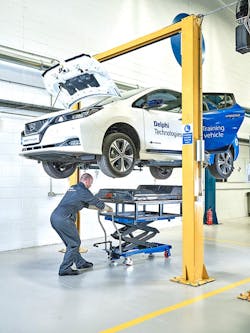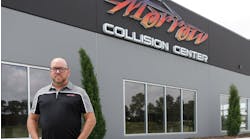Hybrid-electric vehicles (HEVs) have enjoyed their share of popularity, with 5.4 million sold between 1999 and 2019. But that number represents only 1.6 percent of the 333 million new light-duty vehicles sold in that period, and their sales peaked in 2013. U.S. new-car manufacturing is increasingly shifting to battery electric vehicles (BEVs). In its Electric Vehicle Outlook 2020 report, Bloomberg New Energy Finance predicts electric (battery electric and plug-in hybrid) vehicle sales will be 10 percent of global passenger vehicle sales by 2025, 28 percent by 2030, and 58 percent by 2040.
Although materials and many mechanical parts are similar to those of familiar internal combustion engine (ICE) vehicles, your shop needs procedures in place to prevent severe injury or death to your technicians from improper handling of high-voltage components.
Original equipment manufacturers (OEMs) are helping prepare the collision repair industry to repair EVs. In the November CIECast (webinar) for the Collision Industry Electronic Commerce Association (CIECA), Mark Kaufman, global director of electrification for Ford Motor Co., said his company set a goal of 100 Ford Certified Collision Network Centers to be EV-certified in advance of the launch of the Mustang Mach-E EV crossover. EV certification requires eight Inter-Industry Conference on Auto Collision Repair (I-CAR) BEV and HEV training (including some Ford-specific) courses and additional tools and equipment, including that which is needed to handle the large, heavy batteries.
General Motors recently announced its pursuit of an “all-electric future” by 2035, and in the next four years, it plans to introduce 30 new electric vehicles (EVs) worldwide. John Eck, collision manager of the wholesale dealer channel for General Motors Customer Care and Aftersales, is confident that collision repairers who follow OEM-recommended repair procedures and general safety considerations for high-voltage systems will readily adapt to repairing EVs.
“From a structural standpoint, the impact probably won’t be as noticeable as what we’ve seen over the years with the introduction of some brand-new substrates,” he said in the January CIECast.
I-CAR has multiple hybrid and EV courses available, including OEM-specific ones for OEM-certification programs, and it continues to develop more.
Jeff Poole, I-CAR manager and subject matter expert, helped develop some of those courses. As the collision repair industry prepares for the wave of incoming EVs, he draws a comparison to its adjustment to repair the first mainstream aluminum-intensive vehicle, the 2015 Ford F-150. It was at that point, he says, that many shops had to make a choice: train personnel and add tools and equipment to safely and properly repair the new vehicle, or turn down those repairs and allow another shop to take them on.
“I look at this as something the shops and the technicians need to make a decision about for their future,” Poole says. “Waiting until that patient is on the operating table to try to figure out what to do is the wrong time to be cracking the book for the first time and looking it up.”
Poole says OEMs have done a good job of building safe “floating” high-voltage systems, which, to simplify the explanation a bit, are isolated from the chassis ground. But it’s still critical to observe all safety precautions when working around high voltage (such as when removing and installing the battery) and to use recommended personal protective equipment (PPE), such as class 0 1000V-rated insulated gloves (which must be professionally tested every six months), and either insulated boots or a rubber floor mat to protect against severe electrical shocks.
As the I-CAR Hybrid, Electric, and Alternative Fuel Vehicle Service course notes, “Powering down the system, regardless of the method, only de-energizes the high voltage circuits and components outside of the HEV/EV battery pack. Dangerous voltage levels always exist within the HEV/EV battery pack. For some vehicles, the system may be powered down by using the scan tool to disable and discharge the high voltage outside of the battery pack.”
Understanding electrical theory is critical before disabling high voltage
I-CAR’s Repairability Technical Support (RTS) Portal provides information on vehicle-specific procedures for how to access the disabling procedure through the OEM (pay) sites, best practices for welding near high-voltage batteries, and if there are any refinish precautions for that vehicle. For many vehicles, there are no adjustments needed, but others place a limit on the booth baking temperature and time. One example is for the 2018 Ford Fusion hybrid, which limits the bake (air) temperature to 140 degrees for 45 minutes.
But before they disable the battery, Poole says, technicians should first be comfortable with basic electrical theory.
“Current is flowing through the wire; you do not want it flowing through your body. Electricity is very persistent; it will find and follow any and every given available path. You don’t want to become a path.
“Whenever these vehicles are being worked on, technicians need to make sure they’re methodical. That way, they have not left a potential mousetrap sitting there in the dark they can’t see. If you understand what you’re working on, you understand what the shutdown procedures are and what’s happening during the shutdown procedures, you then have a better understanding of what happens if for some reason the high voltage contactors are welded shut.”
That scenario doesn’t happen often, Poole notes, but it’s a potential problem to be aware of.
“That’s a high-voltage system fault that needs to be addressed by somebody who has the right training to deal with that. That’s where that technician really needs to understand that particular vehicle and its engineering to the nth degree before they continue working on it and put themselves in a precarious position.”
Kye Yeung, president of European Motor Car Works in Costa Mesa, Calif., figures about 60 percent of his business is repairing electric cars, and his 34,000-square-foot facility is OEM-certified for Aston Martin, Jaguar, Land Rover, McLaren, and is one of the original founder shops for Tesla. Yeung has also applied for certification with newcomers Lucid and Rivian, and he echoes Poole’s insistence to follow proper disabling procedures.
“The right way to do it is to get the procedures and find out how to disable the vehicle and how long it should sit,” he said. “And the most important thing is, what type of work will you be doing on the vehicle? If it’s minor maintenance, then you may be able to disconnect the 12v low-voltage and first responders’ loop, let the vehicle sit idle for at least two minutes, and then you’re probably pretty safe if you want to change your radio out or something simple. Doing bolt-on little items, I would feel that it would be pretty safe.
“But let’s say you need to remove a drivetrain or high-voltage battery or disable the SRS systems or the charging system. If that is the case, you’re usually either taking them out to replace them because of damage or for accessibility. That’s a whole new game now, because if a technician goes into a vehicle in the wrong sequence, he or she can get electrocuted.”
Yeung says it’s critical that technicians use PPE and follow the proper sequence to disconnect the 12v and high-voltage battery and check for high voltage at the charger with the correct equipment.
How to select the right person for the job
Not just any technician may have the aptitude to safely work on an EV, Yeung says.
“For the classes I’ve taken for the OEs that we do work for that have hybrid and electrical vehicles, I was very surprised at how a lot of technicians who attended didn’t know how to use a voltmeter.”
In Yeung’s shop, EV work, such as powering down and removing and reinstalling high-voltage components, is done only by designated technicians. So how does a shop owner or manager know who is the candidate for such a position? Yeung says it starts with knowing a technician’s daily habits.
“If a technician forgot one time to torque a wheel and his initials weren’t on our in-house checkout sheet, I don’t know if he’d be the one I’d be selecting, because all it takes is one time [making a mistake], and it could be fatal. So we want people who have the mindset to repetitively do a particular labor and know that, especially when it comes to something extreme like that, they will follow directions and not shortcut it.”
Conversely, Yeung says, a technician who is conscientious in printing OEM procedures for each repair likely will also have the good habits to properly and safely work around high voltage. At his shop, repairs are often two-tiered, where after the vehicle’s power is disabled, another technician is allowed to perform operations other than removing and replacing the battery. Until then, a hardware store-variety “high-voltage” sign is placed on the car to indicate it has not yet been powered down and is not yet safe to work on.
That said, in the unfortunate event someone receives an accidental shock, the shop is equipped with a six-foot-long insulated rescue hook to allow a rescuer to safely pull the technician from the high voltage without also being shocked, and has staff trained to use an onsite automatic defibrillator.
Disabling procedures may require additional repair considerations
Yeung notes that some OEMs may have additional requirements to power down their vehicles, such as Jaguar. When it was first released to the market, dealership EV-qualified technicians were the only ones allowed to power it down and up with the JLR High Voltage (HV) Lock-Out Tool.
“When you got a car in, you’d almost have to disassemble the vehicle to a certain extent before you sent it to the dealer, because once it came back you couldn’t do a lot of things, including powering the windows down.
“What was surprising was that some of the dealers only had one Lock-Out Tool, so they didn’t have the ability to do more than one car at a time, because all of this is so new to our industry. It is a disrupter in many ways, and because every OEM has a different procedure, you have to be familiar with how to coordinate the repair.”
As of this writing, Yeung says his understanding is that only shops that have gone through Jaguar’s power-down training are allowed to do it in-house. Others can request an EV-certified technician from the dealership (where available) to come to the facility to power down vehicle.
Precautions needed to protect electrical and electronic components
Printing OEM procedures for each repair to ensure they are the latest available and following them closely is critical for another reason, Yeung says: if any welding, spot or MIG/MAG, is needed near an electronic component, the component must first be removed.
“If a technician doesn’t know what’s behind that panel and starts welding it, it can short out that computer or electronic item very easily because of the high-voltage spike. There are a lot of parameters. If you are a certified center for certain OEMs, they dictate how far you need to be from the component or what has to be removed before you do that type of repair.”
Know how to determine the battery health of a collision-damaged EV
The danger of damaged batteries, especially the possibility of starting fires, cannot be discounted. Yet, Poole says, taking some common sense measures can minimize the risk, and if there is any doubt, the vehicle should be quarantined in storage.
“We put together a course on the initial inspection and using a scan tool to take a look at battery data, look at the diagnostic trouble codes, systems, and flagging any problems.”
Shop personnel should first listen for abnormal gurgling or hissing noises, which could indicate a large problem looming. If there are no abnormal noises, personnel should next look for obvious damage to the battery pack, such as dents or punctures. Then, part of the pre-scan should be to monitor battery parameters, Poole says. It’s important that whoever is running the pre-scan is doing more than simply printing a diagnostic trouble code (DTC) report. He recommends viewing high voltage data to look for consistent cell balance, voltages, and temperatures.
“We don’t want to cry wolf, but we want folks to understand that if it’s 4:30 on a Friday afternoon and you get this car in that just ran over a curb and off the road and it’s damaged the battery pack underneath, you probably do not want to park it in your building with the rest of your vehicles over the weekend if you have not determined that vehicle is 100 percent stable or not.”



